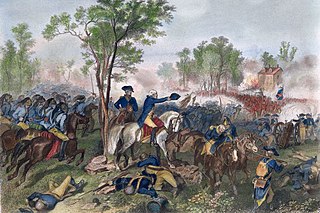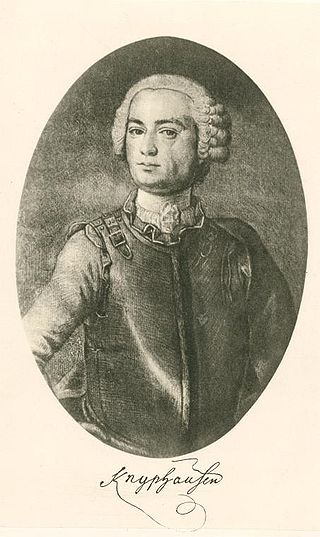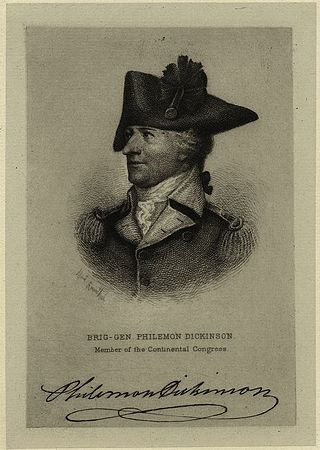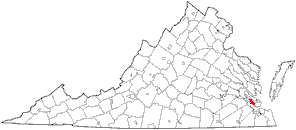
The Battle of Trenton was a small but pivotal American Revolutionary War battle on the morning of December 26, 1776, in Trenton, New Jersey. After General George Washington's crossing of the Delaware River north of Trenton the previous night, Washington led the main body of the Continental Army against Hessian auxiliaries garrisoned at Trenton. After a brief battle, almost two-thirds of the Hessian force were captured, with negligible losses to the Americans. The battle significantly boosted the Continental Army's waning morale, and inspired re-enlistments.

The Battle of White Plains took place during the New York and New Jersey campaign of the American Revolutionary War on October 28, 1776, near White Plains, New York. Following the retreat of George Washington's Continental Army northward from New York City, British General William Howe landed troops in Westchester County, intending to cut off Washington's escape route. Alerted to this move, Washington retreated farther, establishing a position in the village of White Plains but failing to establish firm control over local high ground. Howe's troops drove Washington's troops from a hill near the village; following this loss, Washington ordered the Americans to retreat farther north.

The Battle of Eutaw Springs was a battle of the American Revolutionary War, and was the last major engagement of the war in the Carolinas. Both sides claimed a victory.

The British Legion was an elite British provincial regiment established during the American Revolutionary War, composed of Loyalist American troops, organized as infantry and cavalry, plus a detachment from the 16th Light Dragoons. The unit was commonly known as Tarleton's Legion, after the British officer who led it on campaign, Lieutenant Colonel Banastre Tarleton. It was a unit the size of a regiment, consisting of artillery, cavalry, and light infantry, and able to operate independently.

Wilhelm Reichsfreiherr von Innhausen und Knyphausen was a German general officer who served in Hesse-Kassel. He fought in the American Revolutionary War, during which he commanded Hessian auxiliaries on behalf of Great Britain.

The Battle of Pell's Point, also known as the Battle of Pelham, was a skirmish fought between British and American troops during the New York and New Jersey campaign of the American Revolutionary War. The conflict took place in what is now part of Pelham Bay Park in the Bronx, New York City and the villages of Pelham Manor and Pelham in Westchester County, New York.

The Battle of Springfield was fought during the American Revolutionary War on June 23, 1780, in Union County, New Jersey. After the Battle of Connecticut Farms, on June 7, 1780, had foiled Lieutenant General Wilhelm, Baron von Knyphausen's expedition to attack General George Washington's army at Morristown, New Jersey, Knyphausen and Lieutenant General Sir Henry Clinton, British commander-in-chief in North America, decided upon a second attempt. Although the British were initially able to advance, they were ultimately forced to withdraw in the face of newly arriving rebel forces, resulting in a Continental victory. The battle effectively ended British ambitions in New Jersey.

The Baylor Massacre was an attack by British forces against Continental Army troops on September 27, 1778, during the American Revolutionary War. A force of British soldiers under the command of Major-General Charles Grey carried a successful surprise attack against the 3rd Regiment of Continental Light Dragoons under the command of Colonel George Baylor near present-day River Vale, New Jersey. 15 Continental Army soldiers were killed while a further 54 were wounded or captured by the British, who lost one soldier killed.

The Battle of Millstone, also known as the Battle of Van Nest's Mill, was a skirmish that occurred near the mill of Abraham Van Nest in Weston, New Jersey on January 20, 1777, during the American Revolutionary War. A British foraging party was flanked and driven off by forces composed mostly of New Jersey militia, depriving the British of their wagons and supplies.
The Battle of Connecticut Farms, fought June 7, 1780, was one of the last major battles between British and American forces in the northern colonies during the American Revolutionary War. Hessian General Wilhelm von Knyphausen, in command of the British garrison at New York City, made an attempt to reach the principal Continental Army encampment at Morristown, New Jersey. Knyphausen's advance was strongly met by companies of the New Jersey militia at Connecticut Farms. After stiff resistance, the militia were forced to withdraw, but the battle and skirmishing that preceded it sufficiently delayed Knyphausen's advance that he remained there for the night. After realizing that further advance on Morristown would probably be met by even more resistance, Knyphausen withdrew back toward New York.

The Loyal American Regiment was a British Provincial regiment raised in 1777 for Loyalist service during the American Revolutionary War. The regiment fought in many engagements throughout the war and the men were among the thousands of loyalists who settled in Nova Scotia, after the regiment disbanded in 1783.
The Battle of Mobley's Meeting House was an engagement that occurred during the American Revolutionary War in the Mobley Settlement, Fairfield County, South Carolina during the southern campaign of Lord Cornwallis.

The Battle of Charlotte was an American Revolutionary War battle fought in Charlotte, North Carolina on September 26, 1780. The battle took place at the Mecklenburg County Court House; which is now the site of the Bank of America tower at Trade and Tryon Streets in uptown Charlotte. An advance guard of General Charles Cornwallis' army rode into town and encountered a well-prepared Patriot militia under the command of William R. Davie in front of the court house. A skirmish ensued in which George Hanger, leading the British cavalry, was wounded. The small Patriot force, which had not intended more than token resistance, withdrew north toward Salisbury upon the arrival of Cornwallis and the main army.

The northern theater of the American Revolutionary War after Saratoga consisted of a series of battles between American revolutionaries and British forces, from 1778 to 1782 during the American Revolutionary War. It is characterized by two primary areas of activity. The first set of activities was based around the British base of operations in New York City, where each side made probes and counterprobes against the other's positions that sometimes resulted in notable actions. The second was essentially a frontier war in Upstate New York and rural northern Pennsylvania that was largely fought by state militia companies and some Indian allies on the American side, and Loyalist companies supported by Indians, British Indian agents, and occasionally British regulars. The notable exception to significant Continental Army participation on the frontier was the 1779 Sullivan Expedition, in which General John Sullivan led an army expedition that drove the Iroquois out of New York. The warfare amongst the splinters of the Iroquois Six Nations were particularly brutal, turning much of the Indian population into refugees.

The Queen's Rangers, also known as the Queen's American Rangers, and later Simcoe's Rangers, were a Loyalist military unit of the American Revolutionary War that specialized in cavalry tactics, close combat, irregular warfare, maneuver warfare, raiding, reconnaissance, screening, and tracking. Formed in 1776, they were named for Queen Charlotte, consort of George III. The Queen's Rangers was a light corps in the tradition of British rangers during the Seven Years' War, operating on the flanks and in advance of Crown forces, manning outposts, conducting patrol for screening, and carrying out raiding and reconnaissance operations.

The Skirmish at Waters Creek was a minor action fought on March 8, 1781, during the American Revolutionary War. It was fought near Waters Creek in Newport News, Virginia between a group of local Patriot militia and British Army troops.
Edward Mathew began his military career in the British Army as a commissioned officer. By the time of the American Revolutionary War he had risen to the rank of colonel. Promoted to brigadier general, he was assigned to command the elite Brigade of Guards in the American campaign. In 1776 he led the Guards at Long Island, Kip's Bay, and Fort Washington where he spearheaded one of the assault forces. In the Philadelphia Campaign, he commanded his brigade at Brandywine, Germantown, White Marsh, and Monmouth. As a major general, he took part in the highly successful Chesapeake raid on Virginia ports in 1779. He led one of the columns in action at Battle of Springfield in 1780. He commanded in the West Indies in 1782 and became a full general in 1797. His beloved daughter Anna predeceased him in 1795. Mathew is likely to have been the model for a character in one of Jane Austen's novels.

The Battle of Bull's Ferry on 20 and 21 July 1780 saw two American brigades under Brigadier-General Anthony Wayne attack a party of Loyalists led by Thomas Ward. The Loyalists successfully defended a blockhouse against an ineffective bombardment by four American artillery pieces and a failed attempt to storm the position by Wayne's troops. During the action, American light dragoons under Major Henry Lee III drove off a large number of cattle that were kept in the area for the use of the British forces stationed in New York City. The clash inspired British Major John André to write a satirical ballad entitled The Cow Chace. The skirmish was fought at Bulls Ferry, New Jersey in the Northern theater of the American Revolutionary War after Saratoga. At this stage of the conflict only raids and minor actions occurred in the north.

Colonists who supported the British cause in the American Revolution were Loyalists, often called Tories, or, occasionally, Royalists or King's Men. George Washington's winning side in the war called themselves "Patriots", and in this article Americans on the revolutionary side are called Patriots. For a detailed analysis of the psychology and social origins of the Loyalists, see Loyalist.

The Wytheville Raid or Toland's Raid was an attack by an undersized Union brigade on a Confederate town during the American Civil War. Union Colonel John Toland led a brigade of over 800 men against a Confederate force of about 130 soldiers and 120 civilians. The location of Wytheville, the county seat of Wythe County in southwestern Virginia, had strategic importance because of a nearby lead mine and the railroad that served it. This mine supplied lead for about one third of the Confederate Army's munitions, while the Virginia & Tennessee Railroad transported Confederate troops and supplies; plus telegraph wires along the railroad line were vital for communications. In addition to logistics of moving the lead to bullet manufacturing facilities, this rail line also connected an important salt works of an adjacent county with the wider Confederacy.















